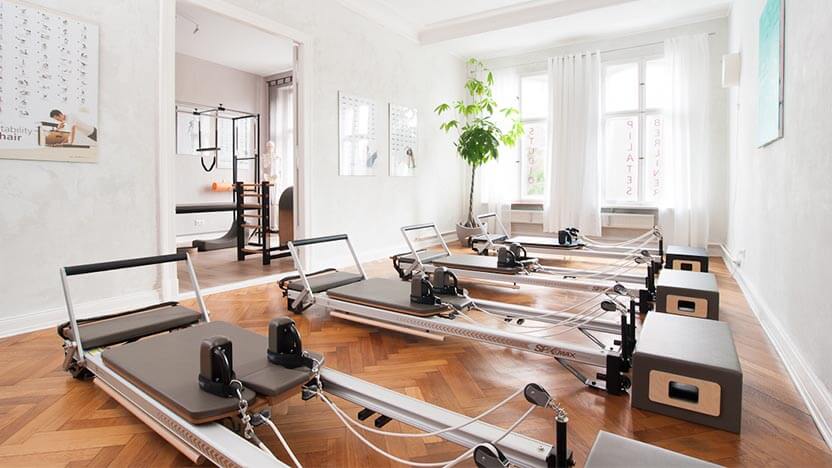
What makes a country fitness-obsessed?
The German fitness market is the largest in Europe with 11.7 million club members, or 14% of the total population working out at one of 9,700 private fitness clubs, and more than $5.5 billion in annual revenue, according to Deloitte’s European Health & Fitness Market Report 2020. It’s a country where consumers prioritize their health and wellness.
We spoke to two Merrithew
® Instructor Trainers based in Germany to find out why that is, how the Pilates industry has evolved, what’s next in fitness and Pilates trends, and how they’re catering to consumers’ new demands as a result of COVID-19.
Why are Germans so invested in their health and wellness?
“Germany has Europe’s largest and strongest economy which may also explain why its health and fitness market ranks above the U.K., France, Italy and Spain,” says Instructor Trainer Deborah Degano, pictured above, owner of Berliner-Pilates, a Merrithew Host Training Center in Berlin.
“The fact that the German population is growing older is also a contributing factor with the geriatric population choosing Pilates, among other activities, due to the many Pilates benefits, including strength training. Around 1.3 million people 70 and older are active in fitness facilities in Germany,” she says.

Michaela Bimbi-Dresp, pictured above, a Lead Instructor Trainer and owner of Pilatesbody, a Licensed Training Center in Munich, agrees that Germans’ economic prosperity helps drive healthier lifestyle choices.
“A healthy lifestyle is more expensive than a sedentary one because of the higher cost of healthy foods and fees for professionals,” she says.
How has the Pilates industry grown and evolved in Germany?
Despite Joseph Pilates being a German native, Pilates hasn’t always been a well-known exercise method in the country.
“When I moved back to Germany in 2002, I tried to offer Pilates to the German fitness industry. Almost nobody knew about it and even the high-end fitness studios in Munich didn’t want to offer Pilates classes,” Michaela says.
“I opened my own Pilates studio and wrote a few Pilates books in German, which were later translated. In 2005, I co-founded the Deutscher Pilates Verband (German Pilates Association) and I would say that from then on Pilates became better known and more popular,” Michaela says.

Over the last five years, with mainstream gyms and various studios offering Pilates classes, the modality has become more widely understood and practiced.
“Pilates training was previously strongly associated with group mat Pilates classes. Only a small proportion of those interested in Pilates experienced the full range of equipment and mat exercises, either individually or in small groups. Nowadays, Reformer Pilates is the most popular offering with classes like HIIT Pilates being especially appealing, ” Deborah says.
What’s next for the German fitness and Pilates industry after COVID-19?

Similar to most countries around the world, the German fitness industry has taken a big hit during the pandemic. The country’s extended lockdown led to partial or complete studio shutdowns and sparked a new interest and demand for digital fitness and Pilates classes.
While many clients had to step back from in-person fitness classes for different reasons, the pandemic also reinforced and raised awareness of the importance of regular physical activity, Deborah says.
“Pilates, being such a complete body and mind training, is certainly in high demand, now more than ever,” she says.
And unlike many other forms of fitness, Pilates is perfectly suited and adaptable to small spaces and remote practice, she adds, creating new opportunities for fitness professionals and studio owners.
“The pandemic has led more people to seek a combination of physical training with mental relaxation. Pilates-yoga hybrids, and fitness combined with mental wellness, are in high demand and represent the most important trends for the current year,” she says.
“I expect in the future we’ll see more health-oriented and holistic wellness fitness offerings catering to specific clientele and risk groups."
The pandemic has also changed consumers’ behavior, presenting a silver lining for small boutique studio owners.
“I would say people tend to prefer to train at smaller, owner-operated boutique studios because they feel safer and they don’t encounter a lot of other people. They pay by the hour, which is fair to them. I’ve seen a rise in private sessions this year,” Michaela says.
“Moving forward, many fitness studios and facilities may want to position themselves as holistic health centers since these facilities were allowed to stay open during the lockdown,” she says.
What do consumers now expect from fitness professionals and studio owners in Germany?

With greater awareness of the importance of physical and mental health and wellness comes a more informed and demanding fitness consumer, Deborah says.
In her opinion, these consumers are looking for:
- A personalized approach
- Well-trained instructors
- Enriching disciplines
“This fact, along with the significant increase in new Pilates practitioners around the world, particularly thanks to online classes, has and will continue to lead to an increasing number of students and customers rethinking their lives and job conditions and becoming attracted to the balanced path designed by Pilates,” she says.
“One of the top European Pilates and yoga studio market trends is the surge in demand for digital classes, with studio owners now offering on-demand and livestream group workouts.
“This digital shift is here to stay even with a decline in COVID-19 infections and the potential end of the pandemic; it cannot be ignored. Combining the convenience of digital Pilates training with the structure, experience and equipment offered at in-person studio classes is going to be key to success.”
Try our streaming platform, Merrithew Connect™, for free for 14
days >